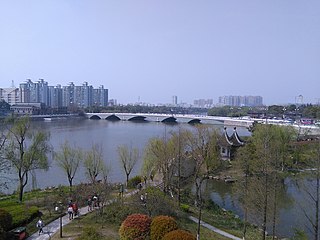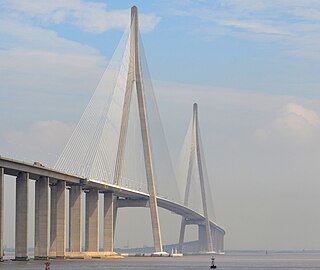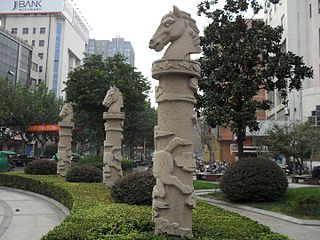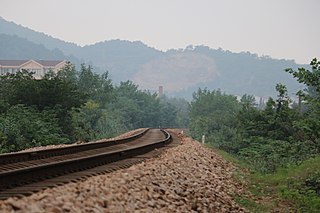
Jiangsu is an eastern coastal province of the People's Republic of China. It is one of the leading provinces in finance, education, technology, and tourism, with its capital in Nanjing. Jiangsu is the third smallest, but the fifth most populous and the most densely populated of the 23 provinces of the People's Republic of China. Jiangsu has the highest GDP per capita and second-highest GDP of Chinese provinces, after Guangdong. Jiangsu borders Shandong in the north, Anhui to the west, and Zhejiang and Shanghai to the south. Jiangsu has a coastline of over 1,000 kilometers (620 mi) along the Yellow Sea, and the Yangtze River passes through the southern part of the province.

Suzhou is a city in southern Jiangsu of eastern China.

Chongming District is the northernmost district of the provincial-level municipality of Shanghai. Chongming consists of three low-lying inhabited alluvial islands at the mouth of the Yangtze north of the Shanghai peninsula: Chongming, Changxing, and Hengsha. Following its massive expansion in the 20th century, Chongming is now the 2nd-largest island administered by the People's Republic of China and the 2nd-largest in Greater China, after Hainan. Chongming does not, however, administer all of the island: owing to its continual expansion from sediment deposited by the Yangtze, it has merged with formerly separate islands and now includes Jiangsu province's pene-exclave townships of Haiyong and Qilong. Chongming proper covers an area of 1,411 km2 (545 sq mi) and had a population of 637,921 at the time of the Census 2020.

Zhenjiang, alternately romanized as Chinkiang, is a prefecture-level city in Jiangsu Province, China. It lies on the southern bank of the Yangtze River near its intersection with the Grand Canal. It is opposite Yangzhou and between Nanjing and Changzhou. Zhenjiang was formerly the provincial capital of Jiangsu and remains as an important transportation hub. As of the 2020 census, its total population was 3,210,418 inhabitants whom 1,266,790 lived in the built-up area made of the 3 urban districts. The town is best known both in China and abroad for Chinkiang vinegar, a fragrant black vinegar that is a staple of Chinese cooking.

Changshu is a county-level city under the jurisdiction of Suzhou, Jiangsu province, and is part of the Yangtze River Delta. It borders the prefecture-level city of Nantong to the northeast across the Yangtze River. Due to the mild climate and terrain there, it has enjoyed a high level of agricultural civilization since ancient times, and is named after this, for the first character of its name means "always, often", while the second means "ripe". The name of the adjacent county-level city of Taicang means "great granary".

Chongming, formerly romanized as Chungming, is an alluvial island at the mouth of the Yangtze River in eastern China covering 1,267 square kilometers (489 sq mi) as of 2010. Together with the islands Changxing and Hengsha, it forms Chongming District, the northernmost area of the provincial-level municipality of Shanghai. At the time of the 2010 Chinese census, its population was 660,000.

Qidong is a county-level city under the administration of the prefecture-level city of Nantong in southeastern Jiangsu province, China. It is located on the north side of the Yangtze River opposite Shanghai and forms a peninsula jutting out into the East China Sea. It has a population of 1.12 million.

Zhangjiagang, formerly Shazhou County, is a county-level city under the administration of Suzhou, Jiangsu province, China and one of the many ports along the Yangtze river.

Taizhou is a prefecture-level city in central Jiangsu province in eastern China. Taizhou is also a member of the Shanghai metropolitan area. Situated on the north bank of the Yangtze River, it borders Nantong to the east, Yancheng to the north and Yangzhou to the west.

The Sutong Yangtze Bridge is a cable-stayed bridge that spans the Yangtze in China between Nantong and Changshu, a satellite city of Suzhou, in Jiangsu province.

Haimen is a district of Nantong, Jiangsu province, with a population of approximately 1 million. It is located at the opposite side of the Yangtze River to Shanghai and is directly north of Chongming Island except for a small portion that forms Haimen District's Haiyong Town. Haimen is the seat of the Roman Catholic Diocese of Haimen. Haimen is located in the poorer north Jiangsu region and together with Qidong City, traditionally has one of the highest rates of liver cancer in China and in the world, with upwards of 1 out of every 10 adults in the rural areas dying from liver cancer.

Jingjiang is a county-level city under the administration of Taizhou, Jiangsu province, China. It is located on the northern (left) bank of the Yangtze River, and is the southernmost part of Taizhou City, bordering Nantong to the northeast, Suzhou to the southeast, Wuxi to the south, Changzhou to the southwest, and Zhenjiang to the west. The area of Jingjiang is 655.6 square kilometres and the population was 684,360 at the 2010 census.
Tong–Tai, also known as Tai–Ru, is a group of Lower Yangtze Mandarin dialects spoken in the east-central part of Jiangsu province in the prefecture-level cities of Nantong and Taizhou. The alternative name refers to the county-level city of Rugao within Nantong. This region includes the areas which are to the north of Yangtze River and to the east of Grand Canal. There are about 11.37 million speakers there and this region occupies about 15,000 square kilometers.

Tongzhou District, formerly known as Tongzhou City (1993-2009) or Nantong County (1912-1993), is one of three urban districts of Nantong, Jiangsu province, China. It was a county-level city under the administration of Nantong until July 2009, when it became a district of Nantong. As of 2010, Tongzhou had a population of 1,246,400.

The Nanjing–Qidong railway, commonly referred to in short as the Ningqi railway, is a higher-speed rail line in Jiangsu Province, China. Its common name is derived from Ning, the one-character abbreviation for Nanjing and Qi, which refers to Qidong, a county-level city of Nantong.

The Xinyi–Changxing railway or Xinchang railway, also known as the Xinchang line, is a single-track railway line in eastern China between the cities of Xinyi in Jiangsu Province and Changxing County in Zhejiang Province. It runs north-south through the entire length of Jiangsu Province and the northern tip of Zhejiang. Major cities along route include Huai'an, Yancheng, Hai'an, Jingjiang, Jiangyin and Yixing. Including a 62.5 km (38.8 mi) spur from Hai'an to Nantong, the Xinchang railway is 638 km (396 mi) in total length. It used a train ferry to cross the Yangtze River, but this closed in 2019. Passenger services south of Hai'an have also been abandoned.

Shanghai–Suzhou–Nantong railway, abbreviated as Husutong railway is a higher-speed railway in China's Yangtze River Delta area, connecting Shanghai, the region's main city located south of the Yangtze, with Nantong in Jiangsu province, north of the river.
Haiyong is a town of Haimen District in Nantong, Jiangsu, China. Together with neighboring Qilong, it forms a pene-enclave of the province on Chongming Island, most of which belongs to the province-level municipality of Shanghai. Haiyong presently covers about 12.5 square kilometers (5 sq mi) and had a population of 5,004 during the year 2000 census.
Qilong is a township of Qidong in eastern Jiangsu province. The land it occupies was formerly Yonglongsha, a separate island in the Yangtze River delta, but reclamation projects and natural deposition of sediment have joined it to Chongming Island, where it now forms a pene-enclave within Shanghai's Chongming County. Its population was 3436 at the time of the 2010 Chinese census. Qilong's name—literally "opening prosperity"—is a compound of contracted forms of its county and its former island.
The Hai'an–Yangkou Port railway, also known as Rudong railway, is a single-track railway branch in Nantong, Jiangsu Province, China. The combined passenger and freight line is 77 kilometres (48 mi) long and has a design speed of 120 kilometres per hour (75 mph).
































